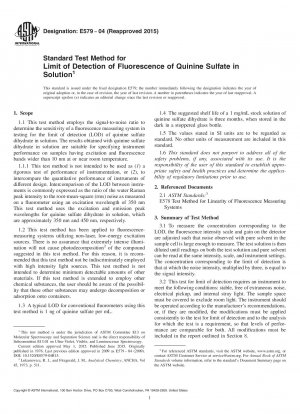ASTM E579-04(2015)
Standard Test Method for Limit of Detection of Fluorescence of Quinine Sulfate in Solution
- Standard No.
- ASTM E579-04(2015)
- Release Date
- 2004
- Published By
- American Society for Testing and Materials (ASTM)
- Status
- Replace By
- ASTM E579-04(2023)
- Latest
- ASTM E579-04(2023)
- Scope
4.1 When determining the limiting detectable concentration of a fluorescent substance, it is usually necessary to increase the readout scale of a photoelectric instrument to a point where noise (that is, random fluctuations of the system) becomes apparent. This noise will be superimposed upon the signal from the sample.
4.2 In molecular fluorescence spectroscopy, the limit of detection for the sample will be determined by the limiting signal-to-noise ratio, S/N, where the signal, S, is the difference between readings obtained with the sample and blank solutions, and N is the total root-mean-square (rms) noise. The limit of detection for the sample will be given by the instrument readings that give a signal equal to three times the rms value of the noise.
Note 2: Factors other than noise affecting the sample concentration corresponding to the limit of detection include: the spectral bandwidths of the excitation and emission monochromators, the intensity of the exciting light that can be concentrated on the sample, the fraction of the fluorescence collected by the detection system, the response time of the detection system, and the purity of the solvent. The size and arrangement of the sample container with respect to the light beams are also important, as they affect both the desired signal and the extraneous signal that only contributes noise.
Note 3: The value of rms noise (N) can be obtained by calculating the standard deviation of a series of readings of the signal from the sample at the peak emission wavelength at approximately 450 nm as follows:

Alternatively, rms noise may be estimated by noting the extreme differences between the members of a series of readings (peak-to-peak noise) and dividing by a factor that is usually taken to be 5.6,8201; ......where:
x = mean of the series of readings, x = value of the individual reading, and n = number of readings. ASTM E579-04(2015) Referenced Document
- ASTM E578 Standard Test Method for Linearity of Fluorescence Measuring Systems
ASTM E579-04(2015) history
- 2023 ASTM E579-04(2023) Standard Test Method for Limit of Detection of Fluorescence of Quinine Sulfate in Solution
- 2004 ASTM E579-04(2015) Standard Test Method for Limit of Detection of Fluorescence of Quinine Sulfate in Solution
- 2004 ASTM E579-04(2009) Standard Test Method for Limit of Detection of Fluorescence of Quinine Sulfate in Solution
- 2004 ASTM E579-04 Standard Test Method for Limit of Detection of Fluorescence of Quinine Sulfate in Solution
- 1998 ASTM E579-84(1998) Standard Test Method for Limit of Detection of Fluorescence of Quinine Sulfate

Copyright ©2024 All Rights Reserved